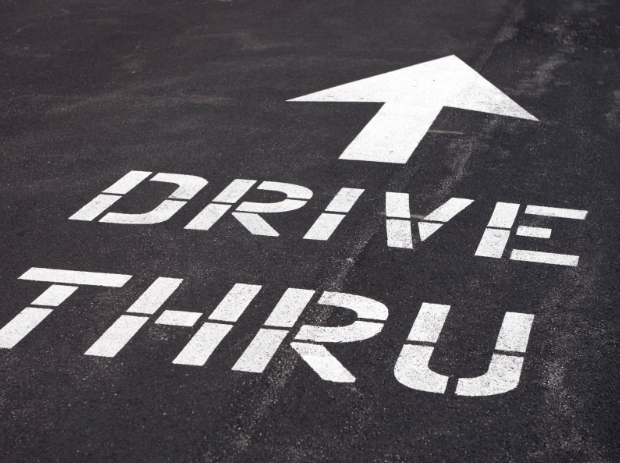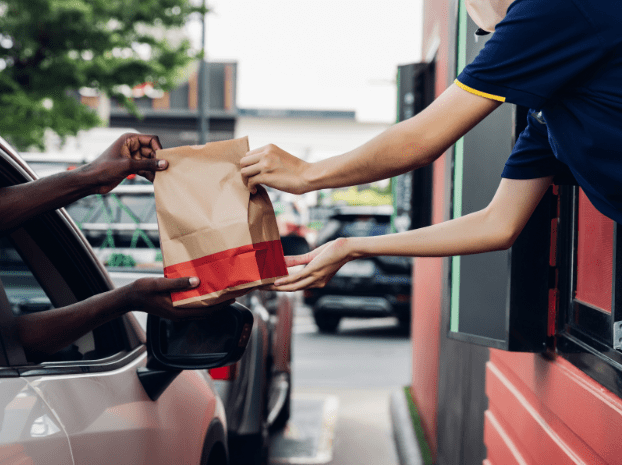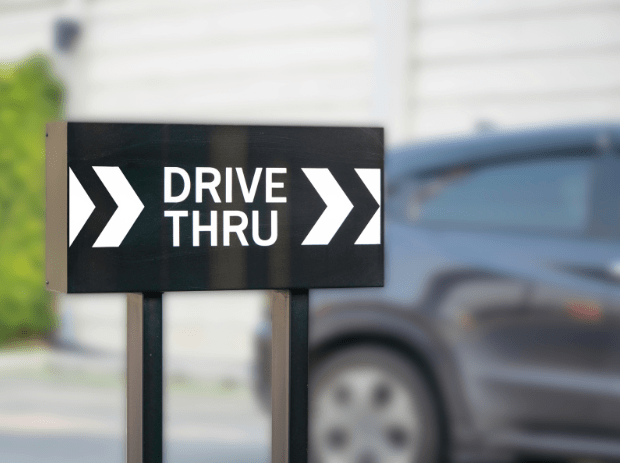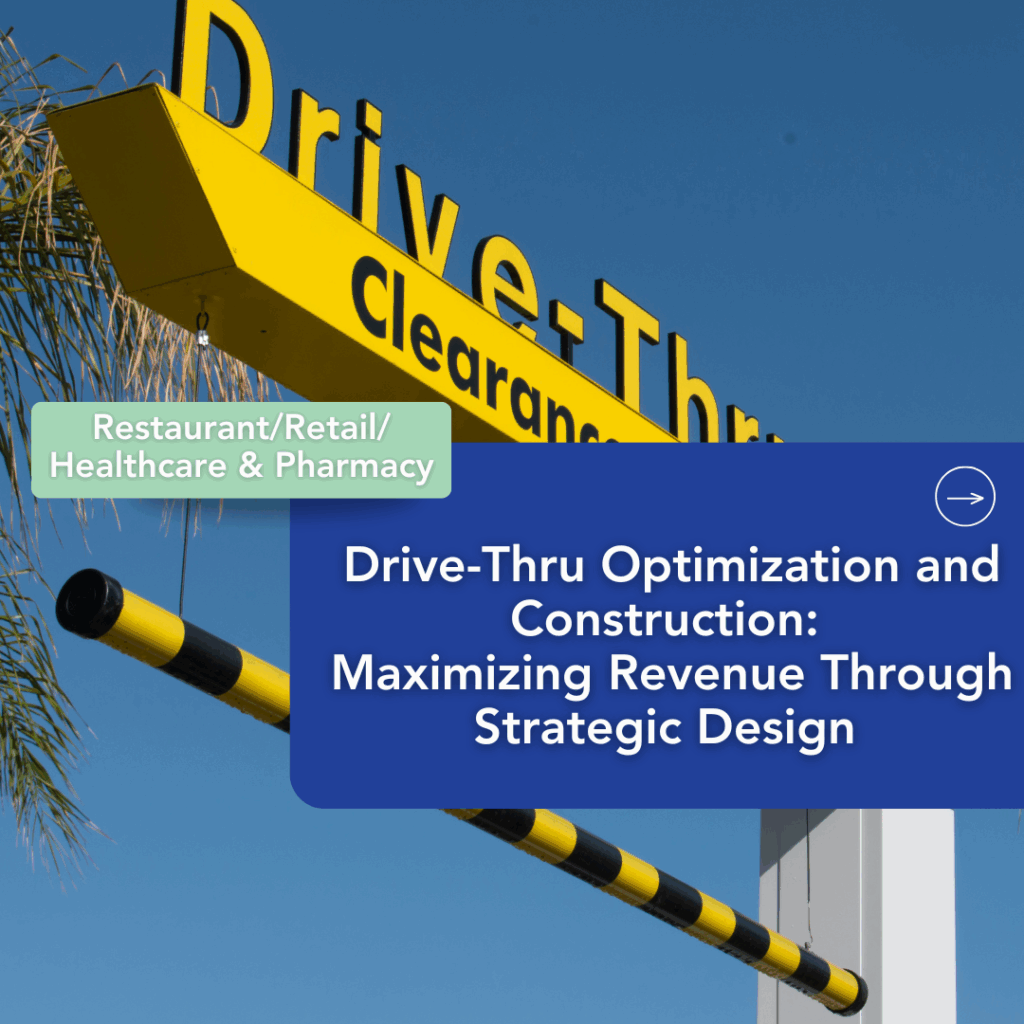Quick Answer
How can drive-thru construction and design improvements increase revenue?
Strategic drive-thru optimization can boost revenue by 10-15% through better traffic flow, shorter wait times, improved customer experience, and higher transaction capacity. Key aspects include lane geometry optimization, technology integration, and sector-specific designs for restaurants, banks, and pharmacies.
Here’s what we’ve learned from designing more than 1,500 drive-thru facilities nationwide.
The Revenue Reality of Smart Drive-Thru Design
When McDonald’s implemented their extensive remodel program across 650 locations— part of the largest in McDonald’s history—drive-thru optimization was a key element that produced measurable revenue gains. That’s not luck—it’s what happens when you get the design right.
Sevan Multi-Site Solutions has years of experience building drive-thru facilities, totaling over 1,500 lanes for major brands like McDonald’s, Walgreens, and 7-Eleven. Here’s what we’ve learned: the difference between a good drive-thru and a great one isn’t just customer satisfaction—it’s cold, hard revenue.

The drive-thru landscape changed dramatically after 2020. Usage increased by 70% across all sectors, and what was once a nice-to-have feature became the core of many businesses. Today, drive-thru sales make up 60-70% of quick-service restaurant revenue. Banking institutions are investing heavily in drive-thru technology, and pharmacies have made drive-thru services essential for patient convenience.
But here’s what’s happening—many businesses are leaving money on the table because they treat drive-thru design as an afterthought.
Why Every Minute Matters in Drive-Thru Design
Let’s discuss numbers for a moment. Strategic drive-thru optimization usually results in 10-25% revenue growth. That’s not just a small bonus—for most businesses, it’s the difference between a good year and an exceptional one.
The payback? Typically 12-18 months.
Sevan has observed clients lowering operational costs by increasing throughput without adding staff. When businesses can serve more customers faster, everyone benefits. Customers receive better service, staff aren’t overwhelmed during busy times, and profits improve.
But the real opportunity extends beyond restaurants. Banking institutions are realizing that advanced drive-thru technology fosters deeper customer engagement. Sevan has collaborated with major financial institutions investing in digital banking integration and multi-service features that transform their drive-thru lanes into full-service banking hubs.
Pharmacy drive-thru services? They are no longer optional. They have become vital for patient convenience, especially for elderly customers and people with mobility challenges. When Sevan designs healthcare and pharmacy facilities, drive-thru accessibility often drives the entire site layout.
Getting the Details Right: Sector-Specific Design
Restaurant Drive-Thru: It's All About Flow
We’ve learned from experience, like the McDonald’s 650+ location remodel program, that geometry matters more than you think. Lane width? 12-14 feet is the sweet spot. Too narrow, and customers feel cramped; too wide, and you’re wasting valuable real estate.
Curve radius is another critical detail. Sevan’s engineers use a minimum 25-foot radius because tighter turns create awkward angles that slow down traffic. When shaving 30 seconds off each transaction during lunch rush, this geometry directly impacts revenue. The queue should be designed to hold 8-12 vehicles without backing up into the parking lot. We’ve seen too many sites where poor planning causes traffic jams that turn customers away.

Modern restaurant construction also means planning for technology infrastructure from the beginning. Digital menu boards with dynamic pricing, mobile ordering pickup lanes, and AI-powered ordering systems aren’t just future concepts—they’re already here. The key is building the electrical and data systems now to support these technologies without needing retrofits later.
Kitchen workflow integration can determine the success of the operation. Sevan designs drive-thru windows to reduce food travel distance, keep temperatures consistent, and establish clear communication between order-takers and fulfillment teams. When the design promotes operational efficiency, service times improve and customer satisfaction increases.
Banking Drive-Thru: Security Meets Convenience
Banking drive-thru construction is a completely different challenge. Security isn’t just important; it’s everything. Today’s cash handling systems include secure storage, document scanning, and integration with digital banking platforms. Many banking clients are surprised by how much ADA compliance requirements influence the entire design. Universal access isn’t just about ramp angles; it also involves reaching controls, providing hearing assistance, and ensuring customers with mobility challenges can complete complex transactions without leaving their vehicles. ATM integration has also become more advanced. Banks now want seamless connections between drive-thru teller services and automated systems, enabling customers to perform multiple transaction types in one visit. Mobile banking through QR code scanning and app-based services is becoming standard in new retail banking facilities. Our work with VyStar Credit Union shows how modern drive-thru design supports expansion into new markets.
Pharmacy Drive-Thru: Where Privacy is Everything
If you think banking security is complex, try designing a pharmacy drive-thru. Patient privacy isn’t negotiable, and every design decision focuses on protecting confidential health information and ensuring accessibility. Sound barriers are just the start. At Sevan, we create visual screening for consultations, secure prescription handling with proper chain of custody, and temperature-controlled storage for medications that need specific climate conditions. The technology infrastructure must support electronic health record access while upholding the highest security standards. Many healthcare facility projects require extended consultation capabilities. Patients need to be able to discuss medications privately with pharmacists, ask questions about side effects, and receive professional medical advice—all from their car. Insurance processing integration adds another layer of complexity. Real-time verification systems, prescription ready notifications, and emergency protocol infrastructure all need to operate seamlessly while protecting patient confidentiality.
The Technology Behind the Experience
Technology integration is a key factor in the success or failure of many drive-thru projects. It’s no longer enough to simply run power and consider the job done anymore.
Mobile app connectivity has raised the stakes. Customers now expect to order ahead, pay via their phones, and pick up without waiting in the regular line. However, what most businesses overlook is that supporting this technology requires much more than just a Wi-Fi connection.
Data processing demands mean upgrading electrical systems, adding server capacity, and establishing redundant internet connections. Contactless payment options now include everything from digital wallets to cryptocurrency, each needing different backend systems.
Real-time traffic monitoring has transformed how drive-thru operations are managed. Installed technology and analytics systems track wait times, capacity use, customer behavior, and even predict peak periods to optimize staffing. When businesses identify patterns in their data, they can improve both customer satisfaction and revenue.
Futureproofing involves planning for 5G connectivity, electric vehicle charging integration, and automation systems that are still in development. The goal is to build infrastructure that remains relevant and does not become outdated in five years.
Small Details, Big Revenue Impact
Weather protection may seem like a small detail until you experience a drive-thru during a thunderstorm. Covered queuing areas not only keep customers comfortable but also prevent them from leaving.
Landscape design does more than look attractive; it reinforces brand identity and builds customer loyalty. The plant choices, hardscape materials, and overall aesthetic communicate what customers can expect from your business. A well-designed environment suggests quality, attention to detail, and care for the customer experience.
Lighting is where safety meets marketing. Strategic illumination improves security for customers and staff while highlighting architectural features and brand elements. Good lighting also makes your facility visible and inviting in the early morning and evening hours when many drive-thru transactions happen.
Your signage and wayfinding systems directly impact revenue by reducing customer confusion and improving traffic flow. Clear navigation prevents backups, shortens transaction times, and eliminates frustration that might push customers to competitors.
Digital signage offers dynamic upselling opportunities that static menus can’t match. Real-time promotional content, weather-based suggestions, and inventory-driven menu adjustments can significantly boost average transaction size. Don’t forget about the Instagram factor—when customers share photos of their drive-thru experience on social media, you get free marketing.
Accessibility should never be an afterthought. Universal design accommodates various age groups, technological comfort levels, and physical abilities. When you go beyond minimum ADA requirements, you expand your potential customer base and foster positive community relationships.
The Construction Reality: Keeping Your Business Running
Construction planning begins well before Sevan breaks ground. Site assessment determines if drainage can handle extra impervious surface, if electrical service supports new technology systems, and if local traffic patterns can accommodate increased volume.
Traffic impact studies are more than bureaucratic formalities; they serve as roadmaps for success. Navigating permitting and zoning is a specialized process since land use requirements vary greatly between jurisdictions, and drive-thru facilities often trigger additional reviews. Fire safety planning for emergency vehicle access, environmental permits for stormwater management, and noise ordinance compliance all influence the final design.
Most business owners are primarily concerned with staying open during construction. Sevan employs phased strategies to minimize disruptions to customer service. Temporary solutions are used to sustain revenue during the completion of permanent improvements.
The main objective is to finish construction without losing customers or revenue. When executed correctly, customers hardly notice the ongoing construction and will definitely appreciate the improved experience afterward.
What Goes Wrong (And How to Avoid It)
The biggest mistake Sevan sees? Underestimating queue space. Business owners look at their current volume and plan accordingly, then wonder why they have traffic backing up into the street during growth periods or peak times. Always plan for success. Infrastructure gaps in technology are costly to fix after construction. Running conduit and pulling wire during construction costs a fraction of what retrofitting requires.
Sight line obstructions might seem obvious, but they’re more common than you think. Landscaping that blocks views of menu boards, architectural features that hide approaching traffic, or lighting that causes glare all reduce safety and operational efficiency.
Utility coordination during construction has caused more project delays than any other issue. Water, sewer, electrical, gas, and telecommunications must all work together. When utility companies don’t coordinate their schedules, delays and costs increase sharply.
Weather contingency planning is more important than you realize. Scheduling construction around seasonal factors prevents delays and protects completed work. A poorly timed project can lose months to weather delays that proper planning could have avoided.
What's Coming Next in Drive-Thru Design

Robotic food preparation and AI customer service systems are progressing from pilot programs to widespread use. Voice recognition and automated ordering systems need careful infrastructure planning. At Sevan, we are already designing kitchen spaces and drive-thru lanes with automation in mind, even when clients aren’t ready to implement these technologies immediately.
Autonomous vehicle integration presents unique design challenges. Self-driving cars may alter traffic flow, eliminate certain sight lines, and require different communication systems. The pickup mechanisms now being designed need to serve both human drivers and autonomous vehicles.
Multi-modal service integration is already changing drive-thru design. Curbside pickup, delivery driver accommodations, walk-up service windows, and bike and scooter access must all coexist within the same facility. The program management approach we use at Sevan assists clients in planning multiple service models simultaneously. Our experience with 7-Eleven’s remodel and rebrand initiatives shows how fuel and convenience stores are evolving their services to meet shifting customer expectations.
Proving the Value: How to Measure Success
The numbers don’t lie, and success in drive-thru optimization is clearly reflected in performance metrics. Improvements in average transaction value indicate how well your upselling strategies are working. Increases in transaction volume show whether your capacity upgrades are paying off.
Tracking customer lifetime value reveals the long-term effects of improved service experiences. Cost per transaction metrics demonstrate operational efficiency gains—you’re able to serve more customers without proportional increases in labor costs.
Reducing service time is often the most immediate and visible improvement. Even shaving off 15-30 seconds from average transaction times can, during peak periods, lead to significant capacity gains. Higher order accuracy rates are directly linked to customer satisfaction and repeat business.
Peak period management capacity indicates whether your setup can handle busy times like lunch rushes, morning commutes, or holiday shopping seasons. Staff productivity metrics show if workflow improvements are actually making employees more efficient.
Tracking Net Promoter Score offers insights into customer loyalty that can predict long-term business success. Reducing complaints through design improvements demonstrates how the physical environment influences customer satisfaction. When accessibility standards go beyond requirements, you often see noticeable improvements in customer demographics and community engagement.
Enhancements in brand perception may seem intangible, but customer survey data reveal how changes to the physical environment affect overall brand image and customer expectations.
FAQ Section
How much does drive-thru construction typically cost?
Drive-thru construction costs vary greatly depending on complexity, location, and sector requirements. Restaurant drive-thru projects usually range from $150,000 to $500,000, while banking and pharmacy installations often need additional specialized equipment, which can raise costs to $300,000-$750,000. The investment is generally justified by revenue increases of 10-25% within the first year.
What is the typical ROI timeline for drive-thru optimization projects?
Most drive-thru optimization projects see a positive ROI within 12-18 months. Revenue gains of 10-25% are often achieved through strategic design improvements, with top performers experiencing payback in less than 12 months. Key factors influencing ROI include baseline traffic volume, local market conditions, and the level of optimization implemented.
Can existing buildings be retrofitted with drive-thru capabilities?
Yes, many existing buildings can be successfully retrofitted with drive-thru capabilities through careful planning. Success depends on site layout, available space for proper traffic flow, local zoning laws, and utility infrastructure capacity. Sevan Multi-Site Solutions has extensive experience assessing retrofit feasibility and designing solutions that work within current constraints.
What technology infrastructure should be planned during drive-thru construction?
Essential technology infrastructure includes high-speed fiber internet connectivity, sufficient electrical capacity for digital systems, structured cabling for POS and communication systems, and provisions for future technology upgrades. Additionally, planning should include 5G readiness, electric vehicle charging capability, and automation infrastructure to future-proof the investment.
How do drive-thru requirements differ between restaurants, banks, and pharmacies?
Each sector has distinct requirements: restaurants prioritize food safety, speed, and kitchen integration; banking focuses on security, transaction privacy, and regulatory compliance; pharmacies require HIPAA compliance, medication handling protocols, and consultation capabilities. However, all sectors benefit from optimized traffic flow, customer comfort, and technology integration.
What are the most important design elements for maximizing drive-thru revenue?
Key revenue-maximizing elements include optimized traffic flow to reduce wait times, effective upselling opportunities through digital menu boards, customer comfort features encouraging repeat visits, efficient operational workflows, and technology integration supporting modern customer expectations. The most successful projects balance operational efficiency with exceptional customer experience.
The Bottom Line on Drive-Thru Revenue
After designing over 1,500 drive-thru facilities across the US, we have learned that success depends on understanding specific sector needs, planning thoroughly, and executing with attention to both operational efficiency and customer experience.
The 10-25% revenue increases the company experiences aren’t accidents. They result from thoughtful design choices, proper technology integration, and construction management that keeps businesses operational during improvements.
Drive-thru design will continue to evolve as consumer expectations rise, technology capabilities expand, and new service models appear regularly. The businesses that succeed are those implementing smart optimization strategies today while building infrastructure that won’t become outdated tomorrow. Whether you’re planning a single location upgrade or a multi-site program across hundreds of locations, the key is working with specialists who understand your industry’s unique needs and can deliver measurable business results.
Ready to optimize your drive-thru operations?
Contact us to discuss your project needs, schedule a site assessment, or explore our case studies to see results from drive-thru optimization projects with McDonald’s, Walgreens, 7-Eleven, and VyStar Credit Union.

